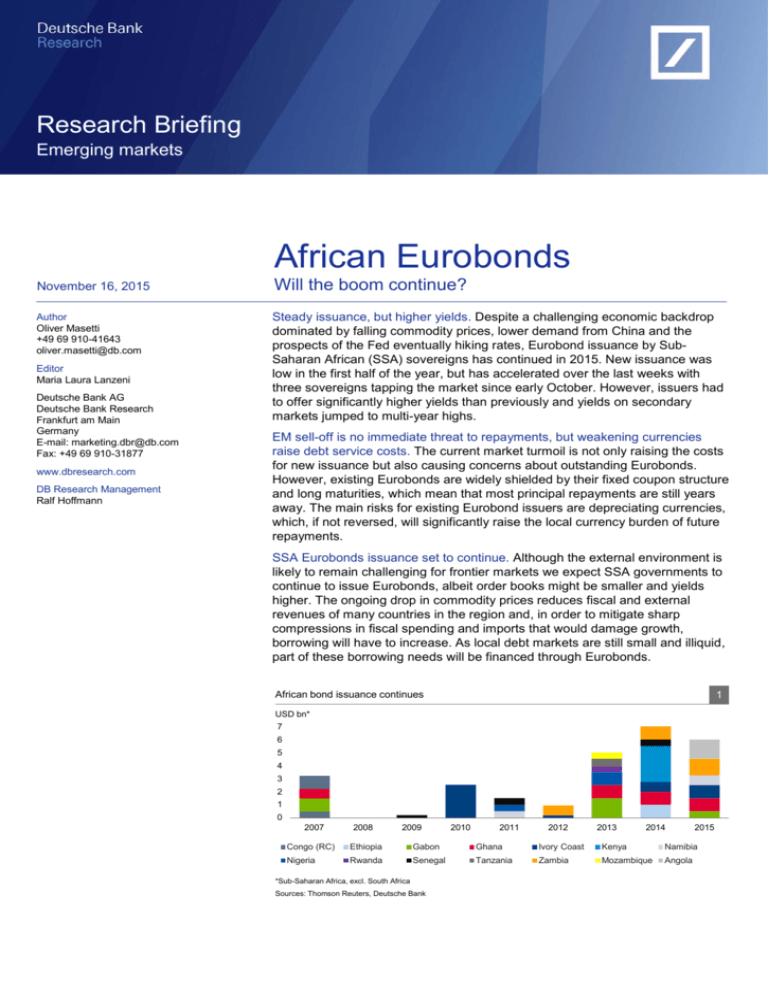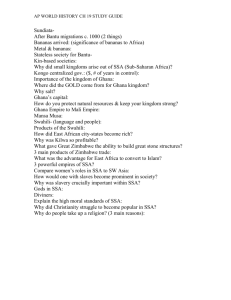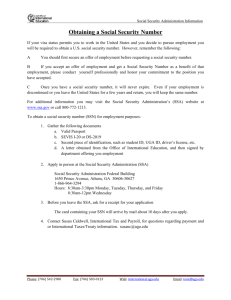
Research Briefing
Emerging markets
African Eurobonds
November 16, 2015
Will the boom continue?
Author
Oliver Masetti
+49 69 910-41643
oliver.masetti@db.com
Steady issuance, but higher yields. Despite a challenging economic backdrop
dominated by falling commodity prices, lower demand from China and the
prospects of the Fed eventually hiking rates, Eurobond issuance by SubSaharan African (SSA) sovereigns has continued in 2015. New issuance was
low in the first half of the year, but has accelerated over the last weeks with
three sovereigns tapping the market since early October. However, issuers had
to offer significantly higher yields than previously and yields on secondary
markets jumped to multi-year highs.
Editor
Maria Laura Lanzeni
Deutsche Bank AG
Deutsche Bank Research
Frankfurt am Main
Germany
E-mail: marketing.dbr@db.com
Fax: +49 69 910-31877
www.dbresearch.com
DB Research Management
Ralf Hoffmann
EM sell-off is no immediate threat to repayments, but weakening currencies
raise debt service costs. The current market turmoil is not only raising the costs
for new issuance but also causing concerns about outstanding Eurobonds.
However, existing Eurobonds are widely shielded by their fixed coupon structure
and long maturities, which mean that most principal repayments are still years
away. The main risks for existing Eurobond issuers are depreciating currencies,
which, if not reversed, will significantly raise the local currency burden of future
repayments.
SSA Eurobonds issuance set to continue. Although the external environment is
likely to remain challenging for frontier markets we expect SSA governments to
continue to issue Eurobonds, albeit order books might be smaller and yields
higher. The ongoing drop in commodity prices reduces fiscal and external
revenues of many countries in the region and, in order to mitigate sharp
compressions in fiscal spending and imports that would damage growth,
borrowing will have to increase. As local debt markets are still small and illiquid,
part of these borrowing needs will be financed through Eurobonds.
African bond issuance continues
1
USD bn*
7
6
5
4
3
2
1
0
2007
2008
2009
2010
2011
2012
2013
2014
2015
Congo (RC)
Ethiopia
Gabon
Ghana
Ivory Coast
Kenya
Namibia
Nigeria
Rwanda
Senegal
Tanzania
Zambia
Mozambique
Angola
*Sub-Saharan Africa, excl. South Africa
Sources: Thomson Reuters, Deutsche Bank
African Eurobonds: Will the boom continue?
Steady issuance, but higher yields in 2015
Higher yields at issue
0
2
%
11
10
9
8
7
6
5
2010
2011
2012
2013
2014
2015
2016
Sources: Reuters, Deutsche Bank
Secondary market yields jumped
3
Bond yield, bp change between 30/08/2014 and
06/11/2015
Zambia
Gabon
Ghana
1
Eurobond issuance by Sub-Saharan African (SSA) continued in 2015. Issuance
was low in the first half of the year, but has accelerated in recent weeks. As of
early-November six sovereigns – Angola, Gabon, Ghana, Ivory Coast, Namibia,
and Zambia - have issued bonds worth USD 6 bn. This puts annual issuance
volume in line with the record levels seen in 2013 and 2014 when twelve
countries, many of them debut issuers, placed bonds worth USD 12 bn in
international capital markets. The continuous issuance comes despite adverse
global developments such as the drop in commodity prices, the slowdown in
China and the prospect of rising US interest rates as well as domestic
developments such as the Ebola outbreak in West Africa or the election
uncertainties in Nigeria and Zambia. The increased economic problems of many
SSA countries are also evident in recent rating downgrades. As of earlyNovember, 7 out of 23 rated sovereigns in SSA have been downgraded in 2015.
While the challenging economic backdrop has not prevented new issuance, it
has resulted in higher yields. Those countries that did issue in 2015 had to offer
significantly higher yields than previously. For Zambia and Ivory Coast, primary
market yields increased by 70 bp and 100 bp respectively, and for Ghana, even
2
by 260 bp to 10.75% in relation to the last issues in 2014. Angola, the only
debut issuer in 2015, had to offer a yield of 9.5%. Yields increased also on
secondary markets, with the increase being highest for commodity exporters
with weakening fiscal and/or external fundamentals such as Zambia, Gabon,
Ghana and Nigeria. Also demand was less lavish. Zambia’s recent bond sale
attracted USD 2.5 bn in orders compared with nearly USD 12 bn for its 2012
bond.
Nigeria
EM sell-off no immediate threat to repayments, but weakening
currencies raise debt service costs
Kenya
Namibia
Ivory Coast
Senegal
Rwanda
0
200
Source: Bloomberg
400
The recent global market turmoil has not only raised the costs for new Eurobond
issuance, but also caused concerns about SSA’s ability to repay its outstanding
bonds. We estimate that the outstanding Eurobonds require around USD 42 bn
in principal and interest repayment. In USD terms, future debt service costs are
highest for Ivory Coast, Ghana, Zambia, Kenya and Gabon. These countries
Gabon, Ivory Coast, Zambia and Ghana face the highest repayment burden
4
USD m
8,000
25%
6,000
20%
15%
4,000
10%
2,000
5%
0
0%
Principal (left)
Interest (left)
NPV, % of GDP (right)
Sources: Bloomberg, Deutsche Bank
1
2
2
| November 16, 2015
Throughout this paper we only refer to frontier markets in SSA and thus exclude South Africa.
For comparing the yield levels it has to be considered that the bonds have different maturities.
For example, the Ghana 2014 bond has a 11-year maturity whereas the 2015 bond has a 15-year
maturity.
Research Briefing
African Eurobonds: Will the boom continue?
Only small repayment over the next
few years
5
USD bn
8
6
4
2
Principal
2032
2030
2028
2026
2024
2022
2020
2018
2016
0
Interest
Sources: Bloomberg, Deutsche Bank
Plunging currencies
6
USD/LC, % yoy, as of 7/11/2015
Zambia
Angola
Namibia
Uganda
Tanzania
Ghana
Nigeria
IvoryCoast
Senegal
Congo (RC)
Gabon
Kenya
Rwanda
Ethiopia
-50% -40% -30% -20% -10%
Sources: Bloomberg, Deutsche Bank
have to repay between USD 7 bn and USD 4 bn. In terms of debt service costs
in relation to the size of the domestic economy, Gabon, Ivory Coast, Zambia,
Ghana and Namibia stand out. The net present value (NPV) of scheduled
repayments in USD exceeds 13% of current GDP in those countries, meaning
that they face high repayment burdens. For all other countries the net present
value of debt repayments is below 10% of GDP.
We think that the near-term risk of the current sell-off for existing issuers is
limited. Nearly all sovereign Eurobonds issued in SSA have a plain vanilla fixed
coupon structure meaning that repayment costs are not affected by the
movements of secondary market yields. Also roll-over risks are low as most
bonds were issued only a few years ago and have long maturities (average
maturity is 11 years) and hence most of the repayments are still years ahead.
Over the next 5 years there are mainly interest payments outstanding, with most
of the principal not to be repaid until after 2020. Overall, the combined annual
costs of servicing the currently outstanding Eurobonds will remain below USD 3
bn until 2021. On an individual country level debt service costs are estimated to
remain below one percent of current GDP for most countries until 2020. Only
Ivory Coast (in 2018, 2019), Gabon (2017), Ghana (2017) and Kenya (2019) are
set to experience annual repayment costs exceeding this threshold. There is a
major bunching of maturities only in 2024, when USD 7.2 bn in principal has to
be repaid and Kenya, Uganda, Ivory Coast, Senegal, Gabon and Zambia each
have to repay principal and interest of more than three percent of their current
GDP.
The main longer term risk for SSA Eurobond issuers stems from the
depreciation of their exchange rates against the USD. The currencies of all
African Eurobond issuers have depreciated against the USD since last summer.
The drop has been most severe for the Zambian kwacha, the Angolan kwanza,
the Namibian dollar, the Ugandan shilling and the Tanzanian shilling which lost
between 51% and 20% yoy against the USD, as of November 7, 2015. As all
outstanding sovereign Eurobonds in SSA are denominated in USD the
depreciation, if not reversed in the future, will have a direct effect on the local
currency value of debt service payments. The local currency net present value
of future debt service payments has increased sharply over the last year. The
increase is highest for Zambia where the NPV doubled. The depreciation in
Namibia, Ghana, Gabon and Ivory Coast and Uganda also has a significant
impact on the discounted local currency value of future debt service needs.
0%
Weakening currencies push debt service costs up
7
Change in local currency NPV of debt service costs due to the change in the exchange rate between 07/11/2015
and 07/11/2014
18
16
14
12
10
8
6
4
2
0
100%
80%
60%
40%
20%
0%
pp of GDP yoy (left)
% yoy (right)
Source: Deutsche Bank
3
| November 16, 2015
Research Briefing
African Eurobonds: Will the boom continue?
SSA Eurobond issuance set to continue
Although the external environment is likely to remain challenging for frontier
markets, with commodity prices unlikely to recover to past record highs and the
Federal Reserve eventually raising interest rates, we still expect that sovereign
Eurobond issuance in SSA will continue. Issuance yields might be significantly
higher and order books smaller, but African sovereigns will continue to tap
international markets. This conjecture has been strengthened by the wave of
issuance since early October.
Commodity price drop raises the need for borrowing...
SSA faces rising financing needs
8
% of GDP
0
-1
-2
-3
-4
-5
-6
2011
2012
2013
Fiscal balance
2014
2015
2016
Current account
Source: IMF
Eurobond issuance will be primarily driven by rising borrowing needs of SubSaharan African governments. The recent drop in commodity prices sharply
reduces fiscal and current account receipts for many commodity exporters in the
region. The IMF estimates that SSA’s aggregate fiscal deficit will increase from
3.5% of GDP in 2014 to 4.2% of GDP in 2015 and the aggregate current
account deficit from 4% of GDP in 2014 to 5.6% of GDP in 2015. The aggregate
numbers, however, hide stark differences across countries in the region.
Especially affected by the drop in commodity prices are Africa’s large oil
producers Nigeria, Angola and Gabon, as well as copper-dependent Zambia.
These countries face significant revenue shortfalls in 2015 and, in the absence
of alternative revenue sources they either have to cut fiscal expenditures and
imports or increase borrowing. As governments usually prioritise current
spending on wages and salaries, spending cuts would most likely fall
predominantly on capital investment. In Nigeria, for example, hardly any capital
investment project was initiated in H1 2015. A lasting reduction in capital
investment, however, would halt the necessary upgrade of Africa’s dysfunctional
infrastructure and thus significantly harm growth prospects.
To cushion the magnitude of these required spending cuts and to mitigate the
effect on growth and job creation, we expect that many countries will opt to
bridge the funding gap by ramping up borrowing.
... which is difficult to finance domestically.
Shallow domestic debt markets
Outstanding domestic bonds, % of GDP
Sources: Thomson Reuters, Deutsche Bank
4
| November 16, 2015
9
Borrowing can theoretically be obtained from domestic as well as international
sources. However, SSA’s ability to finance rising fiscal and current account
deficits domestically is limited by its mainly small and illiquid domestic debt
markets. With the exception of South Africa, which has a highly developed
capital market, debt markets are still in the early stages of development and
capitalisation is usually very low. Nigeria, the largest market after South Africa,
has roughly USD 50 bn in domestic bonds outstanding, but this corresponds to
only around 10% of GDP. Besides South Africa, only two countries, Mauritius
and Ghana, have a domestic bond market capitalisation exceeding 40% of
GDP. Therefore, in many cases an exclusive reliance on domestic markets for
financing large deficits would quickly crowd out credit extension to the private
sector and further cloud the growth outlook. Additionally, liquidity in African debt
markets is low and the markets are characterised by low turnover rates as most
investors adopt a buy-and-hold strategy. The lack of size and liquidity, in
combination with the currency risk associated with investing in local currency
bonds as well as the risk of capital controls, means that many international
investors are relatively reluctant to buy domestically issued local currency debt.
Eurobonds are thus a potential way to tap a broader investor base. This is also
facilitated by the fact that most SSA Eurobonds are included in global bond
indices. In contrast, after JP Morgan’s decision to exclude Nigeria from its local
currency government bond index in early September 2015, no country in SSA
(with the exception of South Africa) is included in a major local currency bond
index.
Research Briefing
African Eurobonds: Will the boom continue?
Another impediment for funding large deficits domestically is that many SSA
countries face troubles in raising long-term debt domestically. Bond issuance
with a maturity of more than five years is relatively rare and most debt markets
in the region are dominated by short-term instruments, mostly Treasury bills.
Nearly 60% of outstanding local currency debt instruments in SSA have a
maturity of less than three years. International debt securities, on the other side,
offer the possibility of longer-term financing. The average maturity of the
outstanding Eurobonds stands at 10 years.
There is scope for further external debt in most countries.
Lower external debt in SSA
10
% of GDP
70%
60%
50%
40%
30%
20%
10%
0%
2000 2002 2004 2006 2008 2010 2012 2014
Sources: World Bank, IMF
Bonds still account for only a small share
of SSA's external debt
11
% of total external debt
SSA
South Asia
Europe/Central Asia
MENA
East Asia/Pacific
Latin America
0% 20% 40% 60% 80% 100%
Bonds
Commercial banks
Other private creditors
Multilateral
Bilateral
Source: World Bank
Eurobond issuance will contribute to rising external debt levels in SSA.
Especially countries that borrowed heavily over the past few years and are
suffering from plunging currencies which reduce GDP measured in USD, such
as Zambia, Ghana or Angola, will see strong increases in their debt-to-GDP
ratio. However, low external debt stocks on average mean that most other
countries in the region still have scope to increase their external indebtedness
without jeopardising external debt sustainability. Also partly thanks to substantial
debt relief in the past, SSA’s total external debt level stands at a low 14% of
GDP (basically unchanged from 2008) and less than a quarter of the countries
in the region exhibit external debt levels exceeding 30% of GDP. Among
existing Eurobond issuers only Mozambique, Ghana, Senegal and Ivory Coast
have external debt levels of more than 30% of GDP. Regional heavyweight
Nigeria, on the other hand, has an external debt level of only around 3% of
GDP.
Eurobond issuance is also likely to change the composition of SSA’s external
debt. Despite the recent increase in international issuance, bonds still account
for only a small fraction of SSA’s external debt. The share stands at only 6%
compared to 44% for Latin America, for example. Most of SSA’s external debt
still takes the form of multilateral or bilateral official debt. However, the share of
debt held by private creditors is on the rise. It increased from 11% in 2003 to
28% in 2013 and is set to increase further. This increase will be supported by a
rise in the amount of bonds outstanding. Besides continuous sovereign
issuance, this might be facilitated by nascent corporate Eurobond issuance. By
creating a benchmark, repeated issuance of sovereign Eurobonds has set the
stage for corporate issuers in SSA to tap international markets. Corporate
issuance, mainly by banks, has already followed sovereign issuance in Nigeria,
Ghana, Zambia and Kenya. Given the current market turmoil and weakening
currencies, foreign appetite for SSA assets is likely to remain muted and
corporate Eurobond issuance rare in the short term. However, in the longer run,
attractive yields and the huge growth potential of domestic consumer markets
might make SSA corporate issuers look increasingly attractive.
Oliver Masetti (+49 69 910-41643, oliver.masetti@db.com)
5
| November 16, 2015
Research Briefing
African Eurobonds: Will the boom continue?
© Copyright 2015. Deutsche Bank AG, Deutsche Bank Research, 60262 Frankfurt am Main, Germany. All rights reserved. When quoting please cite
“Deutsche Bank Research”.
The above information does not constitute the provision of investment, legal or tax advice. Any views expressed reflect the current views of the author,
which do not necessarily correspond to the opinions of Deutsche Bank AG or its affiliates. Opinions expressed may change without notice. Opinions
expressed may differ from views set out in other documents, including research, published by Deutsche Bank. The above information is provided for
informational purposes only and without any obligation, whether contractual or otherwise. No warranty or representation is made as to the correctness,
completeness and accuracy of the information given or the assessments made.
In Germany this information is approved and/or communicated by Deutsche Bank AG Frankfurt, licensed to carry on banking business and to provide
financial services under the supervision of the European Central Bank (ECB) and the German Federal Financial Supervisory Authority (BaFin). In the
United Kingdom this information is approved and/or communicated by Deutsche Bank AG, London Branch, a member of the London Stock Exchange,
authorized by UK’s Prudential Regulation Authority (PRA) and subject to limited regulation by the UK’s Financial Conduct Authority (FCA) (under
number 150018) and by the PRA. This information is distributed in Hong Kong by Deutsche Bank AG, Hong Kong Branch, in Korea by Deutsche
Securities Korea Co. and in Singapore by Deutsche Bank AG, Singapore Branch. In Japan this information is approved and/or distributed by Deutsche
Securities Limited, Tokyo Branch. In Australia, retail clients should obtain a copy of a Product Disclosure Statement (PDS) relating to any financial
product referred to in this report and consider the PDS before making any decision about whether to acquire the product.
Internet/E-mail: ISSN 2193-5963
6
| November 16, 2015
Research Briefing









